Integrating Literacy and Numeracy in the Australian Curriculum Context
VerifiedAdded on 2023/06/13
|11
|3030
|450
AI Summary
This assignment comprises a series of blog posts focusing on the integration of literacy and numeracy within the Australian Curriculum. The first blog post discusses the importance of literacy and numeracy capabilities, emphasizing the application of mathematical skills in everyday life and professional settings, highlighting the difference between classroom numeracy and real-life application. The second blog post differentiates between numeracy and mathematics, explaining how numeracy involves practical problem-solving in the real world, while mathematics focuses on arithmetic applications and pattern recognition. It also addresses the importance of numeracy in the 21st century, particularly in data-driven decision-making and technological advancements. The third blog post explores how to use authentic practices to teach literacy and numeracy, emphasizing the use of contextual math to create meaningful learning experiences, integrating knowledge across different disciplines, and promoting cognitive development through problem-solving. The final blog post discusses subject-specific literacies in applied mathematics, including business literacy and language literacy, highlighting how these skills influence communication, summarization, and problem-solving approaches in various fields.

Blog Posts
Paraphrase This Document
Need a fresh take? Get an instant paraphrase of this document with our AI Paraphraser
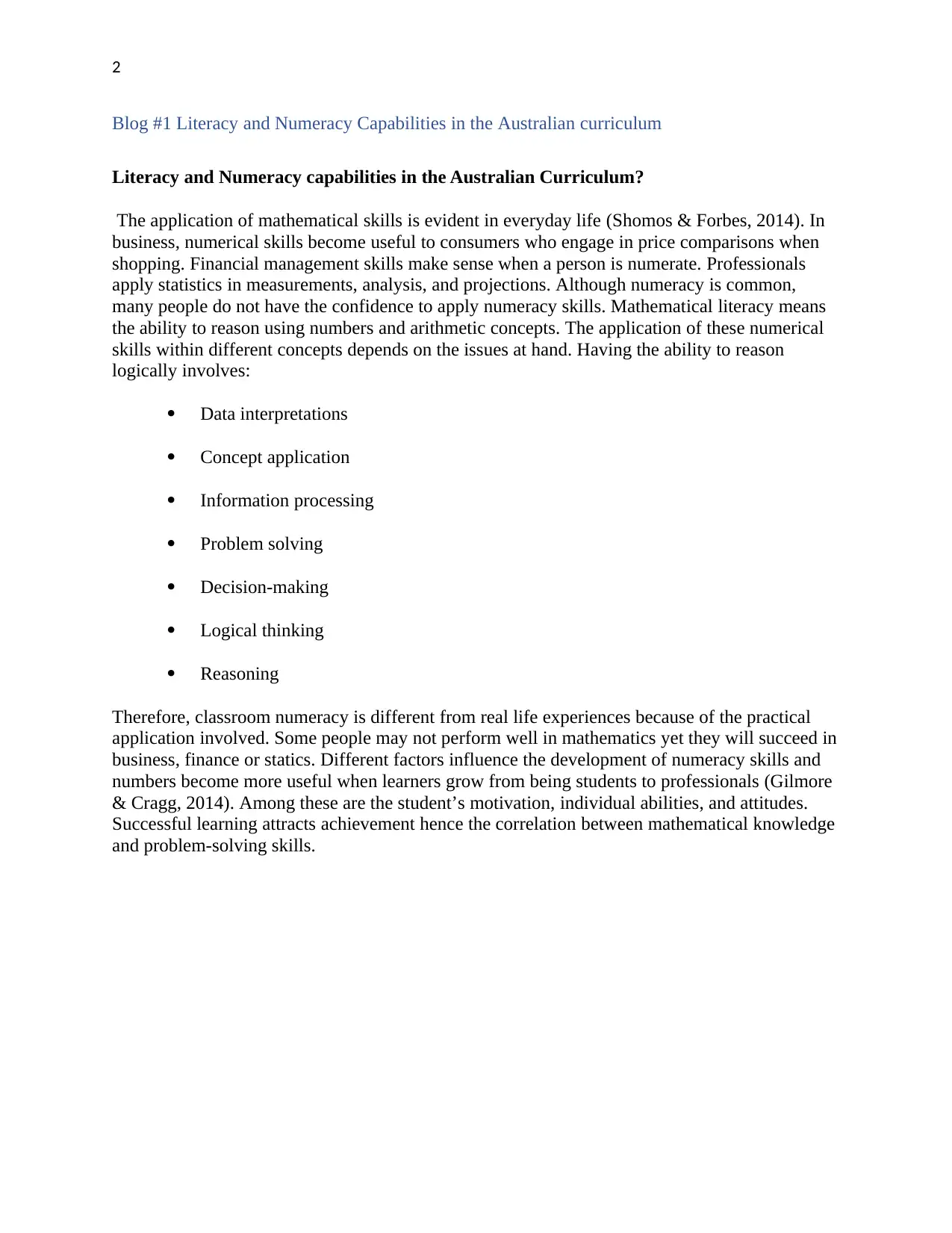
2
Blog #1 Literacy and Numeracy Capabilities in the Australian curriculum
Literacy and Numeracy capabilities in the Australian Curriculum?
The application of mathematical skills is evident in everyday life (Shomos & Forbes, 2014). In
business, numerical skills become useful to consumers who engage in price comparisons when
shopping. Financial management skills make sense when a person is numerate. Professionals
apply statistics in measurements, analysis, and projections. Although numeracy is common,
many people do not have the confidence to apply numeracy skills. Mathematical literacy means
the ability to reason using numbers and arithmetic concepts. The application of these numerical
skills within different concepts depends on the issues at hand. Having the ability to reason
logically involves:
Data interpretations
Concept application
Information processing
Problem solving
Decision-making
Logical thinking
Reasoning
Therefore, classroom numeracy is different from real life experiences because of the practical
application involved. Some people may not perform well in mathematics yet they will succeed in
business, finance or statics. Different factors influence the development of numeracy skills and
numbers become more useful when learners grow from being students to professionals (Gilmore
& Cragg, 2014). Among these are the student’s motivation, individual abilities, and attitudes.
Successful learning attracts achievement hence the correlation between mathematical knowledge
and problem-solving skills.
Blog #1 Literacy and Numeracy Capabilities in the Australian curriculum
Literacy and Numeracy capabilities in the Australian Curriculum?
The application of mathematical skills is evident in everyday life (Shomos & Forbes, 2014). In
business, numerical skills become useful to consumers who engage in price comparisons when
shopping. Financial management skills make sense when a person is numerate. Professionals
apply statistics in measurements, analysis, and projections. Although numeracy is common,
many people do not have the confidence to apply numeracy skills. Mathematical literacy means
the ability to reason using numbers and arithmetic concepts. The application of these numerical
skills within different concepts depends on the issues at hand. Having the ability to reason
logically involves:
Data interpretations
Concept application
Information processing
Problem solving
Decision-making
Logical thinking
Reasoning
Therefore, classroom numeracy is different from real life experiences because of the practical
application involved. Some people may not perform well in mathematics yet they will succeed in
business, finance or statics. Different factors influence the development of numeracy skills and
numbers become more useful when learners grow from being students to professionals (Gilmore
& Cragg, 2014). Among these are the student’s motivation, individual abilities, and attitudes.
Successful learning attracts achievement hence the correlation between mathematical knowledge
and problem-solving skills.
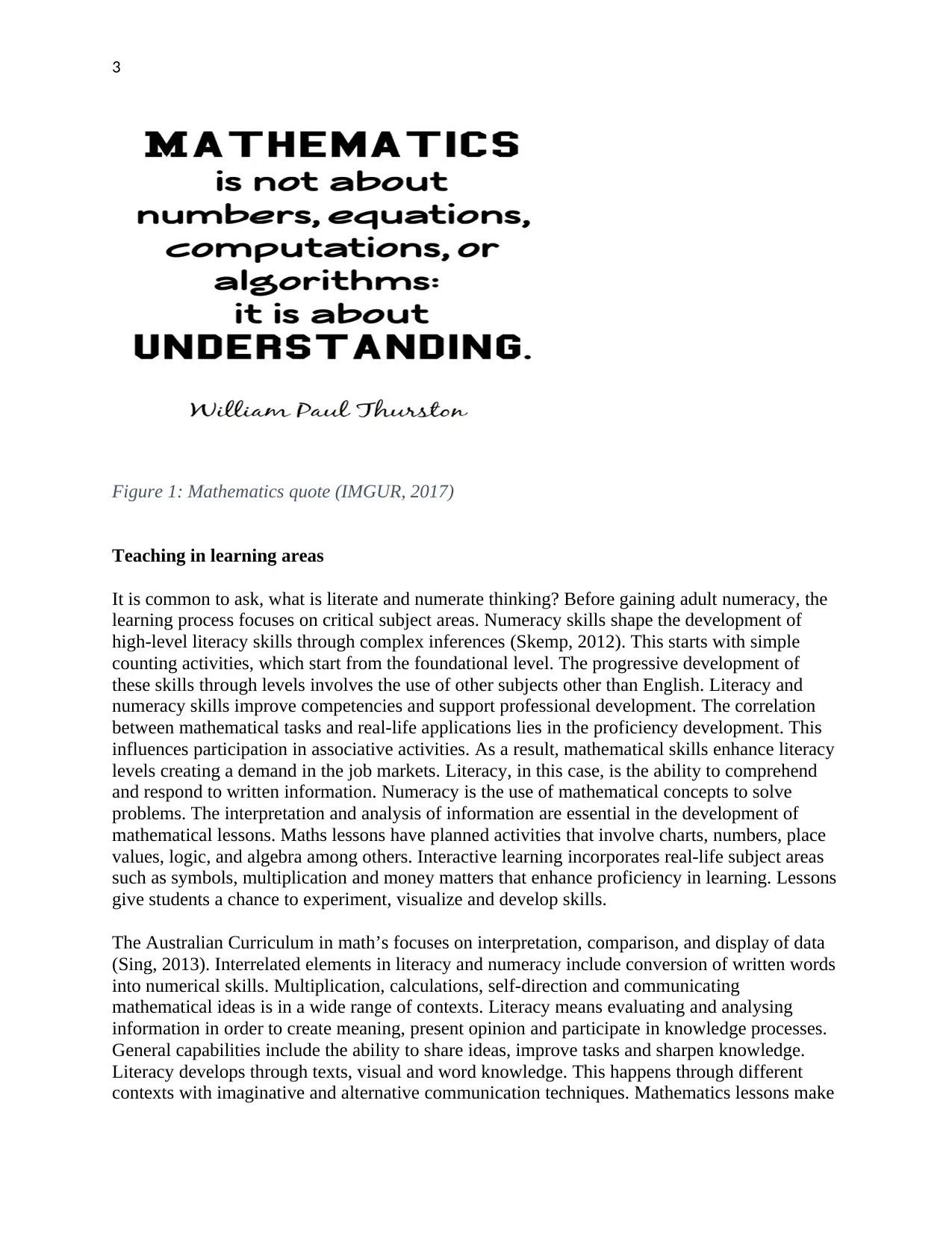
3
Figure 1: Mathematics quote (IMGUR, 2017)
Teaching in learning areas
It is common to ask, what is literate and numerate thinking? Before gaining adult numeracy, the
learning process focuses on critical subject areas. Numeracy skills shape the development of
high-level literacy skills through complex inferences (Skemp, 2012). This starts with simple
counting activities, which start from the foundational level. The progressive development of
these skills through levels involves the use of other subjects other than English. Literacy and
numeracy skills improve competencies and support professional development. The correlation
between mathematical tasks and real-life applications lies in the proficiency development. This
influences participation in associative activities. As a result, mathematical skills enhance literacy
levels creating a demand in the job markets. Literacy, in this case, is the ability to comprehend
and respond to written information. Numeracy is the use of mathematical concepts to solve
problems. The interpretation and analysis of information are essential in the development of
mathematical lessons. Maths lessons have planned activities that involve charts, numbers, place
values, logic, and algebra among others. Interactive learning incorporates real-life subject areas
such as symbols, multiplication and money matters that enhance proficiency in learning. Lessons
give students a chance to experiment, visualize and develop skills.
The Australian Curriculum in math’s focuses on interpretation, comparison, and display of data
(Sing, 2013). Interrelated elements in literacy and numeracy include conversion of written words
into numerical skills. Multiplication, calculations, self-direction and communicating
mathematical ideas is in a wide range of contexts. Literacy means evaluating and analysing
information in order to create meaning, present opinion and participate in knowledge processes.
General capabilities include the ability to share ideas, improve tasks and sharpen knowledge.
Literacy develops through texts, visual and word knowledge. This happens through different
contexts with imaginative and alternative communication techniques. Mathematics lessons make
Figure 1: Mathematics quote (IMGUR, 2017)
Teaching in learning areas
It is common to ask, what is literate and numerate thinking? Before gaining adult numeracy, the
learning process focuses on critical subject areas. Numeracy skills shape the development of
high-level literacy skills through complex inferences (Skemp, 2012). This starts with simple
counting activities, which start from the foundational level. The progressive development of
these skills through levels involves the use of other subjects other than English. Literacy and
numeracy skills improve competencies and support professional development. The correlation
between mathematical tasks and real-life applications lies in the proficiency development. This
influences participation in associative activities. As a result, mathematical skills enhance literacy
levels creating a demand in the job markets. Literacy, in this case, is the ability to comprehend
and respond to written information. Numeracy is the use of mathematical concepts to solve
problems. The interpretation and analysis of information are essential in the development of
mathematical lessons. Maths lessons have planned activities that involve charts, numbers, place
values, logic, and algebra among others. Interactive learning incorporates real-life subject areas
such as symbols, multiplication and money matters that enhance proficiency in learning. Lessons
give students a chance to experiment, visualize and develop skills.
The Australian Curriculum in math’s focuses on interpretation, comparison, and display of data
(Sing, 2013). Interrelated elements in literacy and numeracy include conversion of written words
into numerical skills. Multiplication, calculations, self-direction and communicating
mathematical ideas is in a wide range of contexts. Literacy means evaluating and analysing
information in order to create meaning, present opinion and participate in knowledge processes.
General capabilities include the ability to share ideas, improve tasks and sharpen knowledge.
Literacy develops through texts, visual and word knowledge. This happens through different
contexts with imaginative and alternative communication techniques. Mathematics lessons make
⊘ This is a preview!⊘
Do you want full access?
Subscribe today to unlock all pages.

Trusted by 1+ million students worldwide
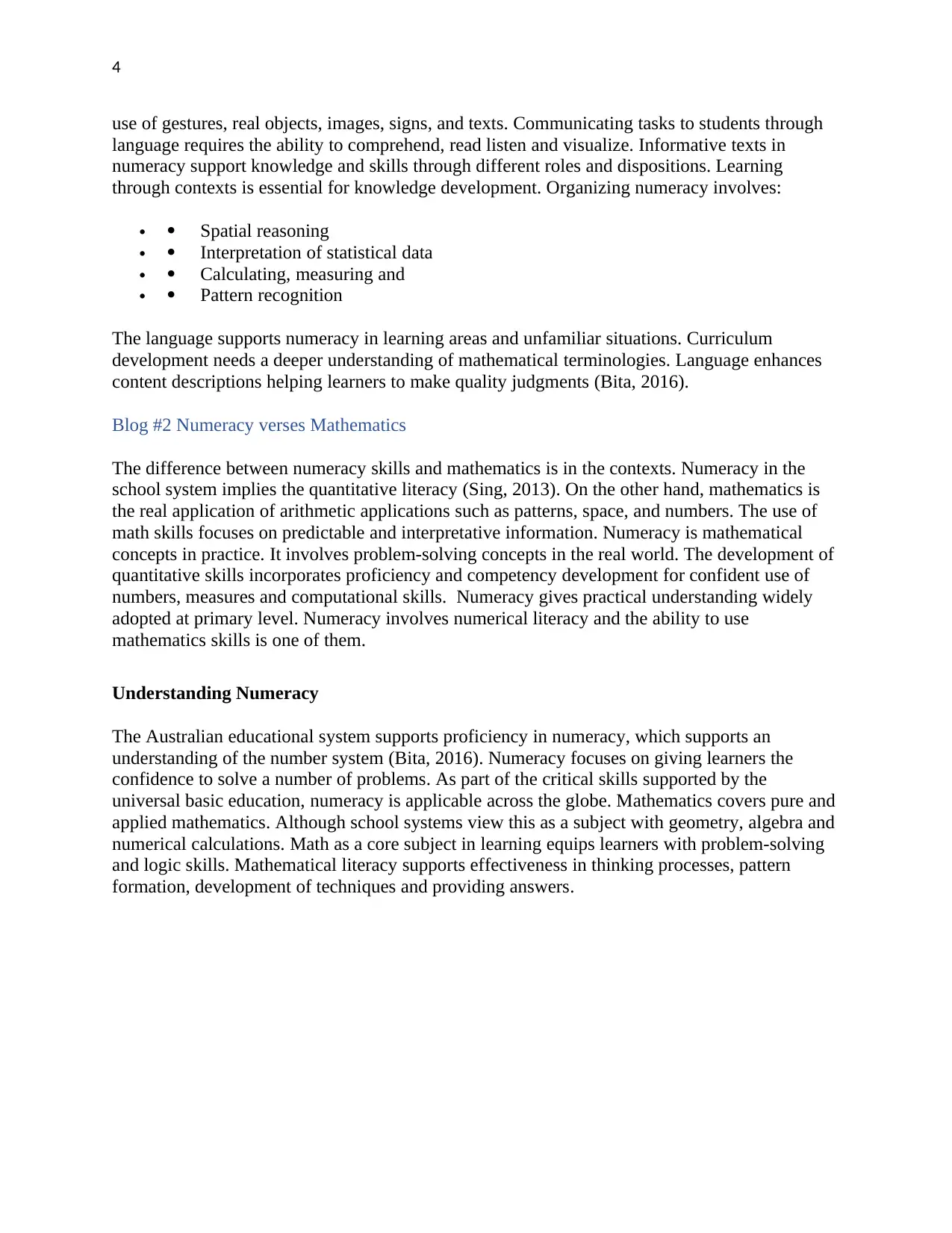
4
use of gestures, real objects, images, signs, and texts. Communicating tasks to students through
language requires the ability to comprehend, read listen and visualize. Informative texts in
numeracy support knowledge and skills through different roles and dispositions. Learning
through contexts is essential for knowledge development. Organizing numeracy involves:
Spatial reasoning
Interpretation of statistical data
Calculating, measuring and
Pattern recognition
The language supports numeracy in learning areas and unfamiliar situations. Curriculum
development needs a deeper understanding of mathematical terminologies. Language enhances
content descriptions helping learners to make quality judgments (Bita, 2016).
Blog #2 Numeracy verses Mathematics
The difference between numeracy skills and mathematics is in the contexts. Numeracy in the
school system implies the quantitative literacy (Sing, 2013). On the other hand, mathematics is
the real application of arithmetic applications such as patterns, space, and numbers. The use of
math skills focuses on predictable and interpretative information. Numeracy is mathematical
concepts in practice. It involves problem-solving concepts in the real world. The development of
quantitative skills incorporates proficiency and competency development for confident use of
numbers, measures and computational skills. Numeracy gives practical understanding widely
adopted at primary level. Numeracy involves numerical literacy and the ability to use
mathematics skills is one of them.
Understanding Numeracy
The Australian educational system supports proficiency in numeracy, which supports an
understanding of the number system (Bita, 2016). Numeracy focuses on giving learners the
confidence to solve a number of problems. As part of the critical skills supported by the
universal basic education, numeracy is applicable across the globe. Mathematics covers pure and
applied mathematics. Although school systems view this as a subject with geometry, algebra and
numerical calculations. Math as a core subject in learning equips learners with problem-solving
and logic skills. Mathematical literacy supports effectiveness in thinking processes, pattern
formation, development of techniques and providing answers.
use of gestures, real objects, images, signs, and texts. Communicating tasks to students through
language requires the ability to comprehend, read listen and visualize. Informative texts in
numeracy support knowledge and skills through different roles and dispositions. Learning
through contexts is essential for knowledge development. Organizing numeracy involves:
Spatial reasoning
Interpretation of statistical data
Calculating, measuring and
Pattern recognition
The language supports numeracy in learning areas and unfamiliar situations. Curriculum
development needs a deeper understanding of mathematical terminologies. Language enhances
content descriptions helping learners to make quality judgments (Bita, 2016).
Blog #2 Numeracy verses Mathematics
The difference between numeracy skills and mathematics is in the contexts. Numeracy in the
school system implies the quantitative literacy (Sing, 2013). On the other hand, mathematics is
the real application of arithmetic applications such as patterns, space, and numbers. The use of
math skills focuses on predictable and interpretative information. Numeracy is mathematical
concepts in practice. It involves problem-solving concepts in the real world. The development of
quantitative skills incorporates proficiency and competency development for confident use of
numbers, measures and computational skills. Numeracy gives practical understanding widely
adopted at primary level. Numeracy involves numerical literacy and the ability to use
mathematics skills is one of them.
Understanding Numeracy
The Australian educational system supports proficiency in numeracy, which supports an
understanding of the number system (Bita, 2016). Numeracy focuses on giving learners the
confidence to solve a number of problems. As part of the critical skills supported by the
universal basic education, numeracy is applicable across the globe. Mathematics covers pure and
applied mathematics. Although school systems view this as a subject with geometry, algebra and
numerical calculations. Math as a core subject in learning equips learners with problem-solving
and logic skills. Mathematical literacy supports effectiveness in thinking processes, pattern
formation, development of techniques and providing answers.
Paraphrase This Document
Need a fresh take? Get an instant paraphrase of this document with our AI Paraphraser
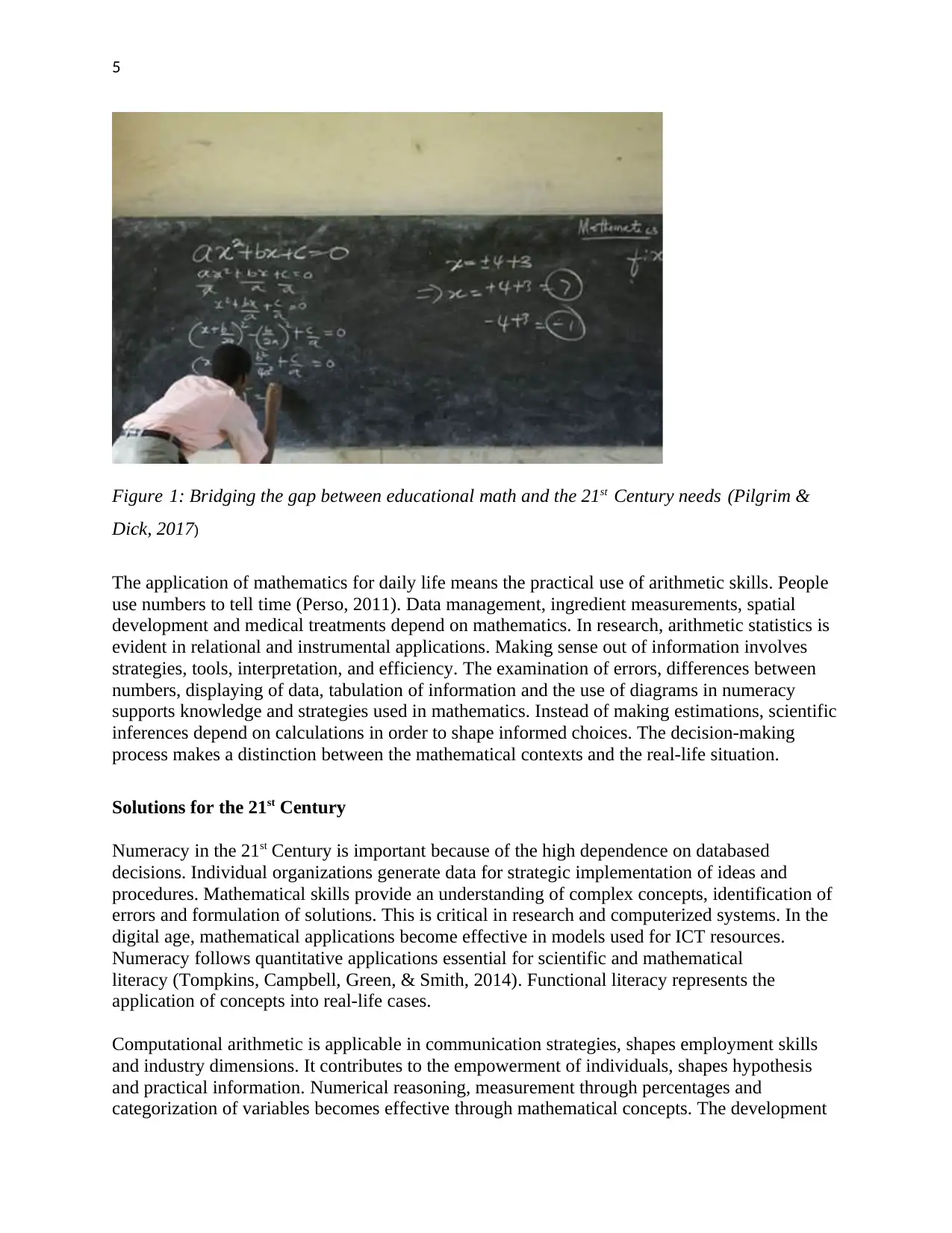
5
Figure 1: Bridging the gap between educational math and the 21st Century needs (Pilgrim &
Dick, 2017)
The application of mathematics for daily life means the practical use of arithmetic skills. People
use numbers to tell time (Perso, 2011). Data management, ingredient measurements, spatial
development and medical treatments depend on mathematics. In research, arithmetic statistics is
evident in relational and instrumental applications. Making sense out of information involves
strategies, tools, interpretation, and efficiency. The examination of errors, differences between
numbers, displaying of data, tabulation of information and the use of diagrams in numeracy
supports knowledge and strategies used in mathematics. Instead of making estimations, scientific
inferences depend on calculations in order to shape informed choices. The decision-making
process makes a distinction between the mathematical contexts and the real-life situation.
Solutions for the 21st Century
Numeracy in the 21st Century is important because of the high dependence on databased
decisions. Individual organizations generate data for strategic implementation of ideas and
procedures. Mathematical skills provide an understanding of complex concepts, identification of
errors and formulation of solutions. This is critical in research and computerized systems. In the
digital age, mathematical applications become effective in models used for ICT resources.
Numeracy follows quantitative applications essential for scientific and mathematical
literacy (Tompkins, Campbell, Green, & Smith, 2014). Functional literacy represents the
application of concepts into real-life cases.
Computational arithmetic is applicable in communication strategies, shapes employment skills
and industry dimensions. It contributes to the empowerment of individuals, shapes hypothesis
and practical information. Numerical reasoning, measurement through percentages and
categorization of variables becomes effective through mathematical concepts. The development
Figure 1: Bridging the gap between educational math and the 21st Century needs (Pilgrim &
Dick, 2017)
The application of mathematics for daily life means the practical use of arithmetic skills. People
use numbers to tell time (Perso, 2011). Data management, ingredient measurements, spatial
development and medical treatments depend on mathematics. In research, arithmetic statistics is
evident in relational and instrumental applications. Making sense out of information involves
strategies, tools, interpretation, and efficiency. The examination of errors, differences between
numbers, displaying of data, tabulation of information and the use of diagrams in numeracy
supports knowledge and strategies used in mathematics. Instead of making estimations, scientific
inferences depend on calculations in order to shape informed choices. The decision-making
process makes a distinction between the mathematical contexts and the real-life situation.
Solutions for the 21st Century
Numeracy in the 21st Century is important because of the high dependence on databased
decisions. Individual organizations generate data for strategic implementation of ideas and
procedures. Mathematical skills provide an understanding of complex concepts, identification of
errors and formulation of solutions. This is critical in research and computerized systems. In the
digital age, mathematical applications become effective in models used for ICT resources.
Numeracy follows quantitative applications essential for scientific and mathematical
literacy (Tompkins, Campbell, Green, & Smith, 2014). Functional literacy represents the
application of concepts into real-life cases.
Computational arithmetic is applicable in communication strategies, shapes employment skills
and industry dimensions. It contributes to the empowerment of individuals, shapes hypothesis
and practical information. Numerical reasoning, measurement through percentages and
categorization of variables becomes effective through mathematical concepts. The development
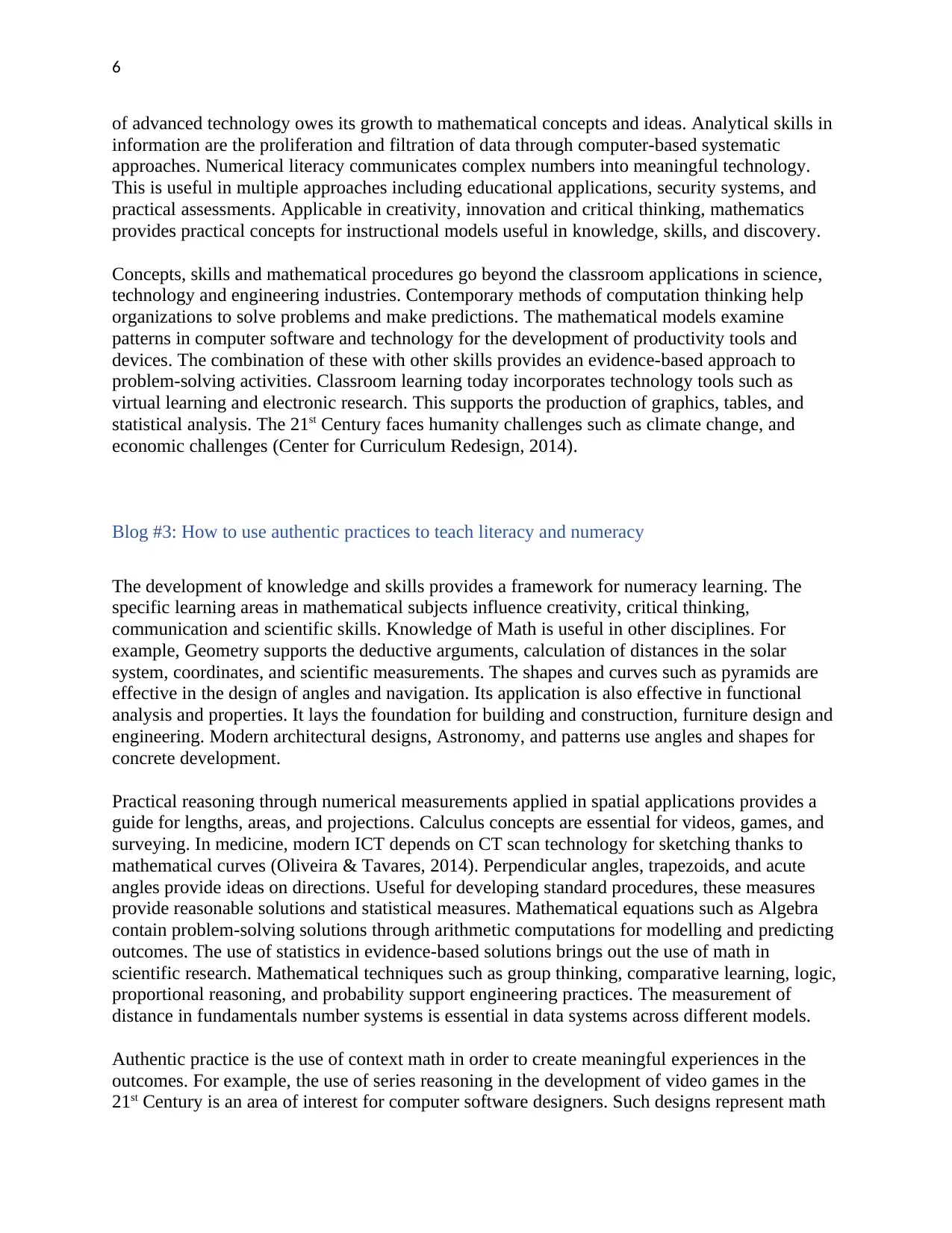
6
of advanced technology owes its growth to mathematical concepts and ideas. Analytical skills in
information are the proliferation and filtration of data through computer-based systematic
approaches. Numerical literacy communicates complex numbers into meaningful technology.
This is useful in multiple approaches including educational applications, security systems, and
practical assessments. Applicable in creativity, innovation and critical thinking, mathematics
provides practical concepts for instructional models useful in knowledge, skills, and discovery.
Concepts, skills and mathematical procedures go beyond the classroom applications in science,
technology and engineering industries. Contemporary methods of computation thinking help
organizations to solve problems and make predictions. The mathematical models examine
patterns in computer software and technology for the development of productivity tools and
devices. The combination of these with other skills provides an evidence-based approach to
problem-solving activities. Classroom learning today incorporates technology tools such as
virtual learning and electronic research. This supports the production of graphics, tables, and
statistical analysis. The 21st Century faces humanity challenges such as climate change, and
economic challenges (Center for Curriculum Redesign, 2014).
Blog #3: How to use authentic practices to teach literacy and numeracy
The development of knowledge and skills provides a framework for numeracy learning. The
specific learning areas in mathematical subjects influence creativity, critical thinking,
communication and scientific skills. Knowledge of Math is useful in other disciplines. For
example, Geometry supports the deductive arguments, calculation of distances in the solar
system, coordinates, and scientific measurements. The shapes and curves such as pyramids are
effective in the design of angles and navigation. Its application is also effective in functional
analysis and properties. It lays the foundation for building and construction, furniture design and
engineering. Modern architectural designs, Astronomy, and patterns use angles and shapes for
concrete development.
Practical reasoning through numerical measurements applied in spatial applications provides a
guide for lengths, areas, and projections. Calculus concepts are essential for videos, games, and
surveying. In medicine, modern ICT depends on CT scan technology for sketching thanks to
mathematical curves (Oliveira & Tavares, 2014). Perpendicular angles, trapezoids, and acute
angles provide ideas on directions. Useful for developing standard procedures, these measures
provide reasonable solutions and statistical measures. Mathematical equations such as Algebra
contain problem-solving solutions through arithmetic computations for modelling and predicting
outcomes. The use of statistics in evidence-based solutions brings out the use of math in
scientific research. Mathematical techniques such as group thinking, comparative learning, logic,
proportional reasoning, and probability support engineering practices. The measurement of
distance in fundamentals number systems is essential in data systems across different models.
Authentic practice is the use of context math in order to create meaningful experiences in the
outcomes. For example, the use of series reasoning in the development of video games in the
21st Century is an area of interest for computer software designers. Such designs represent math
of advanced technology owes its growth to mathematical concepts and ideas. Analytical skills in
information are the proliferation and filtration of data through computer-based systematic
approaches. Numerical literacy communicates complex numbers into meaningful technology.
This is useful in multiple approaches including educational applications, security systems, and
practical assessments. Applicable in creativity, innovation and critical thinking, mathematics
provides practical concepts for instructional models useful in knowledge, skills, and discovery.
Concepts, skills and mathematical procedures go beyond the classroom applications in science,
technology and engineering industries. Contemporary methods of computation thinking help
organizations to solve problems and make predictions. The mathematical models examine
patterns in computer software and technology for the development of productivity tools and
devices. The combination of these with other skills provides an evidence-based approach to
problem-solving activities. Classroom learning today incorporates technology tools such as
virtual learning and electronic research. This supports the production of graphics, tables, and
statistical analysis. The 21st Century faces humanity challenges such as climate change, and
economic challenges (Center for Curriculum Redesign, 2014).
Blog #3: How to use authentic practices to teach literacy and numeracy
The development of knowledge and skills provides a framework for numeracy learning. The
specific learning areas in mathematical subjects influence creativity, critical thinking,
communication and scientific skills. Knowledge of Math is useful in other disciplines. For
example, Geometry supports the deductive arguments, calculation of distances in the solar
system, coordinates, and scientific measurements. The shapes and curves such as pyramids are
effective in the design of angles and navigation. Its application is also effective in functional
analysis and properties. It lays the foundation for building and construction, furniture design and
engineering. Modern architectural designs, Astronomy, and patterns use angles and shapes for
concrete development.
Practical reasoning through numerical measurements applied in spatial applications provides a
guide for lengths, areas, and projections. Calculus concepts are essential for videos, games, and
surveying. In medicine, modern ICT depends on CT scan technology for sketching thanks to
mathematical curves (Oliveira & Tavares, 2014). Perpendicular angles, trapezoids, and acute
angles provide ideas on directions. Useful for developing standard procedures, these measures
provide reasonable solutions and statistical measures. Mathematical equations such as Algebra
contain problem-solving solutions through arithmetic computations for modelling and predicting
outcomes. The use of statistics in evidence-based solutions brings out the use of math in
scientific research. Mathematical techniques such as group thinking, comparative learning, logic,
proportional reasoning, and probability support engineering practices. The measurement of
distance in fundamentals number systems is essential in data systems across different models.
Authentic practice is the use of context math in order to create meaningful experiences in the
outcomes. For example, the use of series reasoning in the development of video games in the
21st Century is an area of interest for computer software designers. Such designs represent math
⊘ This is a preview!⊘
Do you want full access?
Subscribe today to unlock all pages.

Trusted by 1+ million students worldwide
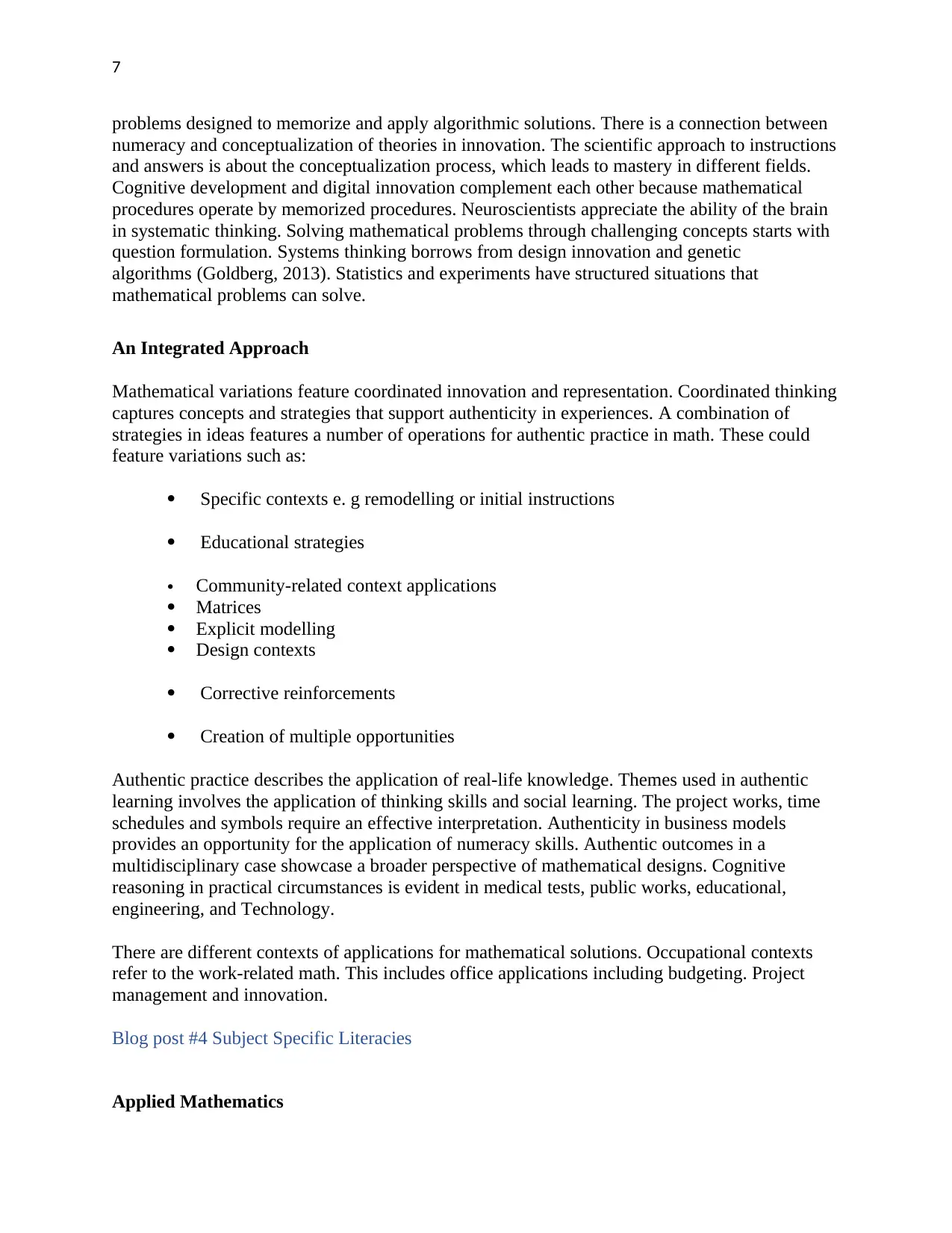
7
problems designed to memorize and apply algorithmic solutions. There is a connection between
numeracy and conceptualization of theories in innovation. The scientific approach to instructions
and answers is about the conceptualization process, which leads to mastery in different fields.
Cognitive development and digital innovation complement each other because mathematical
procedures operate by memorized procedures. Neuroscientists appreciate the ability of the brain
in systematic thinking. Solving mathematical problems through challenging concepts starts with
question formulation. Systems thinking borrows from design innovation and genetic
algorithms (Goldberg, 2013). Statistics and experiments have structured situations that
mathematical problems can solve.
An Integrated Approach
Mathematical variations feature coordinated innovation and representation. Coordinated thinking
captures concepts and strategies that support authenticity in experiences. A combination of
strategies in ideas features a number of operations for authentic practice in math. These could
feature variations such as:
Specific contexts e. g remodelling or initial instructions
Educational strategies
Community-related context applications
Matrices
Explicit modelling
Design contexts
Corrective reinforcements
Creation of multiple opportunities
Authentic practice describes the application of real-life knowledge. Themes used in authentic
learning involves the application of thinking skills and social learning. The project works, time
schedules and symbols require an effective interpretation. Authenticity in business models
provides an opportunity for the application of numeracy skills. Authentic outcomes in a
multidisciplinary case showcase a broader perspective of mathematical designs. Cognitive
reasoning in practical circumstances is evident in medical tests, public works, educational,
engineering, and Technology.
There are different contexts of applications for mathematical solutions. Occupational contexts
refer to the work-related math. This includes office applications including budgeting. Project
management and innovation.
Blog post #4 Subject Specific Literacies
Applied Mathematics
problems designed to memorize and apply algorithmic solutions. There is a connection between
numeracy and conceptualization of theories in innovation. The scientific approach to instructions
and answers is about the conceptualization process, which leads to mastery in different fields.
Cognitive development and digital innovation complement each other because mathematical
procedures operate by memorized procedures. Neuroscientists appreciate the ability of the brain
in systematic thinking. Solving mathematical problems through challenging concepts starts with
question formulation. Systems thinking borrows from design innovation and genetic
algorithms (Goldberg, 2013). Statistics and experiments have structured situations that
mathematical problems can solve.
An Integrated Approach
Mathematical variations feature coordinated innovation and representation. Coordinated thinking
captures concepts and strategies that support authenticity in experiences. A combination of
strategies in ideas features a number of operations for authentic practice in math. These could
feature variations such as:
Specific contexts e. g remodelling or initial instructions
Educational strategies
Community-related context applications
Matrices
Explicit modelling
Design contexts
Corrective reinforcements
Creation of multiple opportunities
Authentic practice describes the application of real-life knowledge. Themes used in authentic
learning involves the application of thinking skills and social learning. The project works, time
schedules and symbols require an effective interpretation. Authenticity in business models
provides an opportunity for the application of numeracy skills. Authentic outcomes in a
multidisciplinary case showcase a broader perspective of mathematical designs. Cognitive
reasoning in practical circumstances is evident in medical tests, public works, educational,
engineering, and Technology.
There are different contexts of applications for mathematical solutions. Occupational contexts
refer to the work-related math. This includes office applications including budgeting. Project
management and innovation.
Blog post #4 Subject Specific Literacies
Applied Mathematics
Paraphrase This Document
Need a fresh take? Get an instant paraphrase of this document with our AI Paraphraser
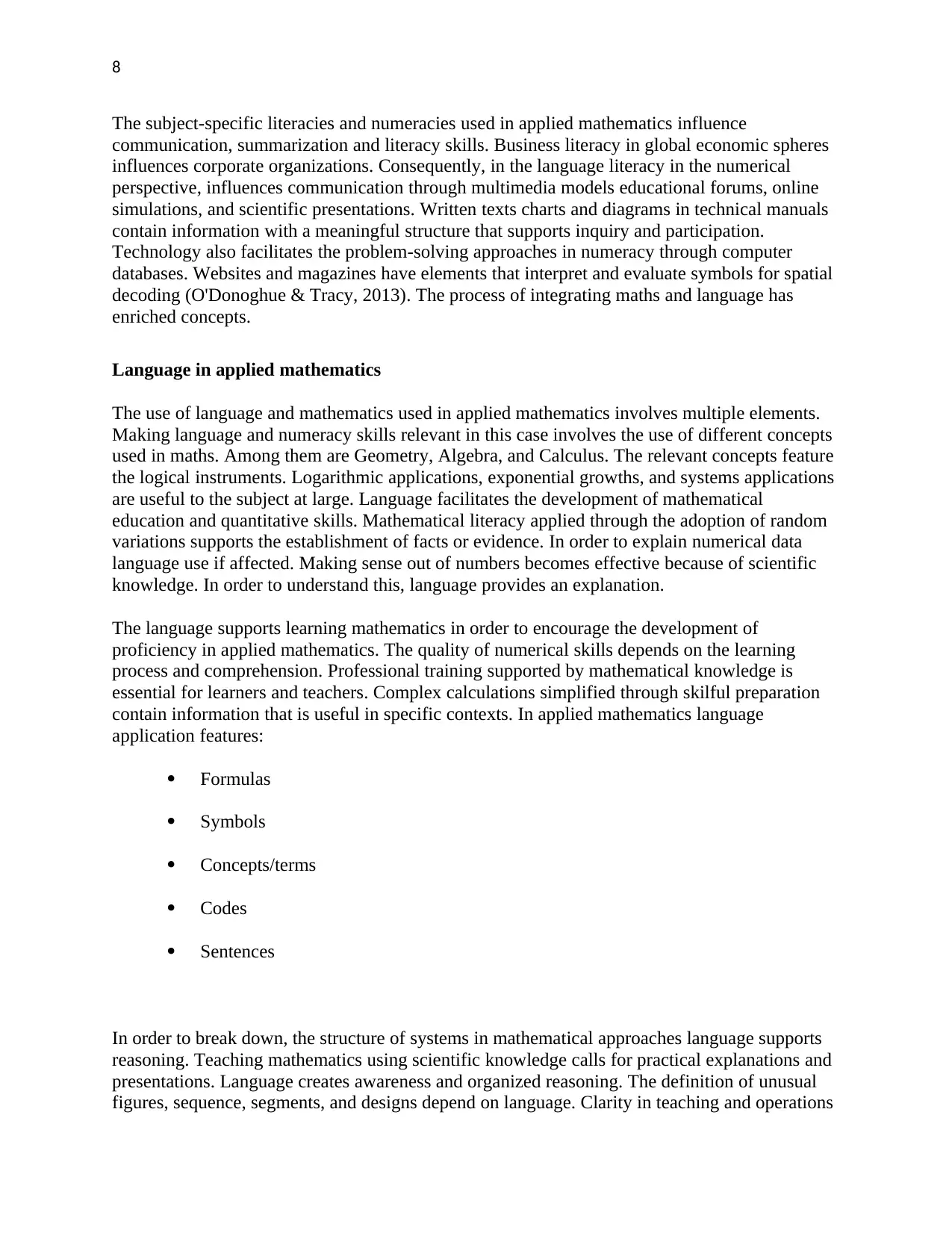
8
The subject-specific literacies and numeracies used in applied mathematics influence
communication, summarization and literacy skills. Business literacy in global economic spheres
influences corporate organizations. Consequently, in the language literacy in the numerical
perspective, influences communication through multimedia models educational forums, online
simulations, and scientific presentations. Written texts charts and diagrams in technical manuals
contain information with a meaningful structure that supports inquiry and participation.
Technology also facilitates the problem-solving approaches in numeracy through computer
databases. Websites and magazines have elements that interpret and evaluate symbols for spatial
decoding (O'Donoghue & Tracy, 2013). The process of integrating maths and language has
enriched concepts.
Language in applied mathematics
The use of language and mathematics used in applied mathematics involves multiple elements.
Making language and numeracy skills relevant in this case involves the use of different concepts
used in maths. Among them are Geometry, Algebra, and Calculus. The relevant concepts feature
the logical instruments. Logarithmic applications, exponential growths, and systems applications
are useful to the subject at large. Language facilitates the development of mathematical
education and quantitative skills. Mathematical literacy applied through the adoption of random
variations supports the establishment of facts or evidence. In order to explain numerical data
language use if affected. Making sense out of numbers becomes effective because of scientific
knowledge. In order to understand this, language provides an explanation.
The language supports learning mathematics in order to encourage the development of
proficiency in applied mathematics. The quality of numerical skills depends on the learning
process and comprehension. Professional training supported by mathematical knowledge is
essential for learners and teachers. Complex calculations simplified through skilful preparation
contain information that is useful in specific contexts. In applied mathematics language
application features:
Formulas
Symbols
Concepts/terms
Codes
Sentences
In order to break down, the structure of systems in mathematical approaches language supports
reasoning. Teaching mathematics using scientific knowledge calls for practical explanations and
presentations. Language creates awareness and organized reasoning. The definition of unusual
figures, sequence, segments, and designs depend on language. Clarity in teaching and operations
The subject-specific literacies and numeracies used in applied mathematics influence
communication, summarization and literacy skills. Business literacy in global economic spheres
influences corporate organizations. Consequently, in the language literacy in the numerical
perspective, influences communication through multimedia models educational forums, online
simulations, and scientific presentations. Written texts charts and diagrams in technical manuals
contain information with a meaningful structure that supports inquiry and participation.
Technology also facilitates the problem-solving approaches in numeracy through computer
databases. Websites and magazines have elements that interpret and evaluate symbols for spatial
decoding (O'Donoghue & Tracy, 2013). The process of integrating maths and language has
enriched concepts.
Language in applied mathematics
The use of language and mathematics used in applied mathematics involves multiple elements.
Making language and numeracy skills relevant in this case involves the use of different concepts
used in maths. Among them are Geometry, Algebra, and Calculus. The relevant concepts feature
the logical instruments. Logarithmic applications, exponential growths, and systems applications
are useful to the subject at large. Language facilitates the development of mathematical
education and quantitative skills. Mathematical literacy applied through the adoption of random
variations supports the establishment of facts or evidence. In order to explain numerical data
language use if affected. Making sense out of numbers becomes effective because of scientific
knowledge. In order to understand this, language provides an explanation.
The language supports learning mathematics in order to encourage the development of
proficiency in applied mathematics. The quality of numerical skills depends on the learning
process and comprehension. Professional training supported by mathematical knowledge is
essential for learners and teachers. Complex calculations simplified through skilful preparation
contain information that is useful in specific contexts. In applied mathematics language
application features:
Formulas
Symbols
Concepts/terms
Codes
Sentences
In order to break down, the structure of systems in mathematical approaches language supports
reasoning. Teaching mathematics using scientific knowledge calls for practical explanations and
presentations. Language creates awareness and organized reasoning. The definition of unusual
figures, sequence, segments, and designs depend on language. Clarity in teaching and operations
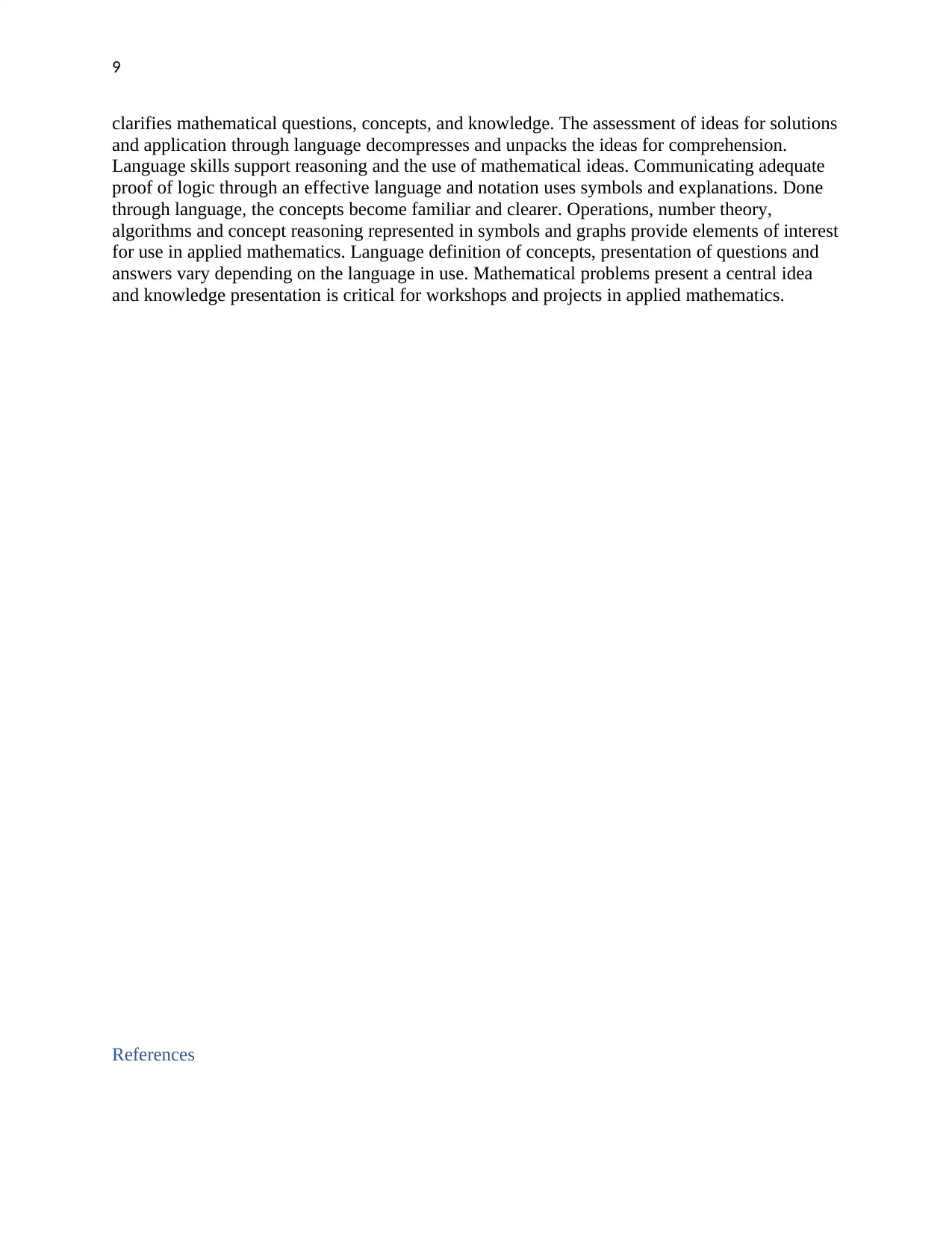
9
clarifies mathematical questions, concepts, and knowledge. The assessment of ideas for solutions
and application through language decompresses and unpacks the ideas for comprehension.
Language skills support reasoning and the use of mathematical ideas. Communicating adequate
proof of logic through an effective language and notation uses symbols and explanations. Done
through language, the concepts become familiar and clearer. Operations, number theory,
algorithms and concept reasoning represented in symbols and graphs provide elements of interest
for use in applied mathematics. Language definition of concepts, presentation of questions and
answers vary depending on the language in use. Mathematical problems present a central idea
and knowledge presentation is critical for workshops and projects in applied mathematics.
References
clarifies mathematical questions, concepts, and knowledge. The assessment of ideas for solutions
and application through language decompresses and unpacks the ideas for comprehension.
Language skills support reasoning and the use of mathematical ideas. Communicating adequate
proof of logic through an effective language and notation uses symbols and explanations. Done
through language, the concepts become familiar and clearer. Operations, number theory,
algorithms and concept reasoning represented in symbols and graphs provide elements of interest
for use in applied mathematics. Language definition of concepts, presentation of questions and
answers vary depending on the language in use. Mathematical problems present a central idea
and knowledge presentation is critical for workshops and projects in applied mathematics.
References
⊘ This is a preview!⊘
Do you want full access?
Subscribe today to unlock all pages.

Trusted by 1+ million students worldwide
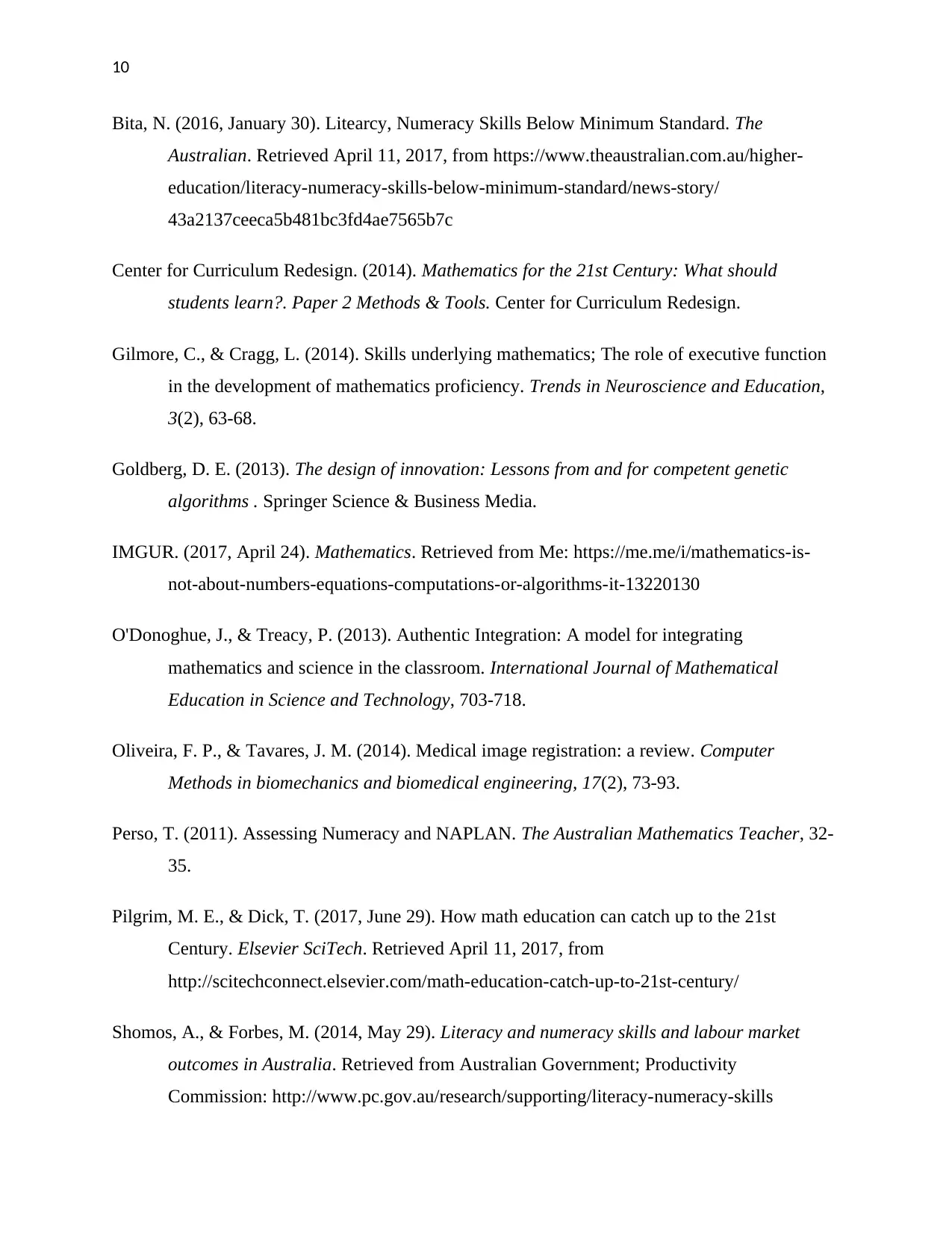
10
Bita, N. (2016, January 30). Litearcy, Numeracy Skills Below Minimum Standard. The
Australian. Retrieved April 11, 2017, from https://www.theaustralian.com.au/higher-
education/literacy-numeracy-skills-below-minimum-standard/news-story/
43a2137ceeca5b481bc3fd4ae7565b7c
Center for Curriculum Redesign. (2014). Mathematics for the 21st Century: What should
students learn?. Paper 2 Methods & Tools. Center for Curriculum Redesign.
Gilmore, C., & Cragg, L. (2014). Skills underlying mathematics; The role of executive function
in the development of mathematics proficiency. Trends in Neuroscience and Education,
3(2), 63-68.
Goldberg, D. E. (2013). The design of innovation: Lessons from and for competent genetic
algorithms . Springer Science & Business Media.
IMGUR. (2017, April 24). Mathematics. Retrieved from Me: https://me.me/i/mathematics-is-
not-about-numbers-equations-computations-or-algorithms-it-13220130
O'Donoghue, J., & Treacy, P. (2013). Authentic Integration: A model for integrating
mathematics and science in the classroom. International Journal of Mathematical
Education in Science and Technology, 703-718.
Oliveira, F. P., & Tavares, J. M. (2014). Medical image registration: a review. Computer
Methods in biomechanics and biomedical engineering, 17(2), 73-93.
Perso, T. (2011). Assessing Numeracy and NAPLAN. The Australian Mathematics Teacher, 32-
35.
Pilgrim, M. E., & Dick, T. (2017, June 29). How math education can catch up to the 21st
Century. Elsevier SciTech. Retrieved April 11, 2017, from
http://scitechconnect.elsevier.com/math-education-catch-up-to-21st-century/
Shomos, A., & Forbes, M. (2014, May 29). Literacy and numeracy skills and labour market
outcomes in Australia. Retrieved from Australian Government; Productivity
Commission: http://www.pc.gov.au/research/supporting/literacy-numeracy-skills
Bita, N. (2016, January 30). Litearcy, Numeracy Skills Below Minimum Standard. The
Australian. Retrieved April 11, 2017, from https://www.theaustralian.com.au/higher-
education/literacy-numeracy-skills-below-minimum-standard/news-story/
43a2137ceeca5b481bc3fd4ae7565b7c
Center for Curriculum Redesign. (2014). Mathematics for the 21st Century: What should
students learn?. Paper 2 Methods & Tools. Center for Curriculum Redesign.
Gilmore, C., & Cragg, L. (2014). Skills underlying mathematics; The role of executive function
in the development of mathematics proficiency. Trends in Neuroscience and Education,
3(2), 63-68.
Goldberg, D. E. (2013). The design of innovation: Lessons from and for competent genetic
algorithms . Springer Science & Business Media.
IMGUR. (2017, April 24). Mathematics. Retrieved from Me: https://me.me/i/mathematics-is-
not-about-numbers-equations-computations-or-algorithms-it-13220130
O'Donoghue, J., & Treacy, P. (2013). Authentic Integration: A model for integrating
mathematics and science in the classroom. International Journal of Mathematical
Education in Science and Technology, 703-718.
Oliveira, F. P., & Tavares, J. M. (2014). Medical image registration: a review. Computer
Methods in biomechanics and biomedical engineering, 17(2), 73-93.
Perso, T. (2011). Assessing Numeracy and NAPLAN. The Australian Mathematics Teacher, 32-
35.
Pilgrim, M. E., & Dick, T. (2017, June 29). How math education can catch up to the 21st
Century. Elsevier SciTech. Retrieved April 11, 2017, from
http://scitechconnect.elsevier.com/math-education-catch-up-to-21st-century/
Shomos, A., & Forbes, M. (2014, May 29). Literacy and numeracy skills and labour market
outcomes in Australia. Retrieved from Australian Government; Productivity
Commission: http://www.pc.gov.au/research/supporting/literacy-numeracy-skills
Paraphrase This Document
Need a fresh take? Get an instant paraphrase of this document with our AI Paraphraser
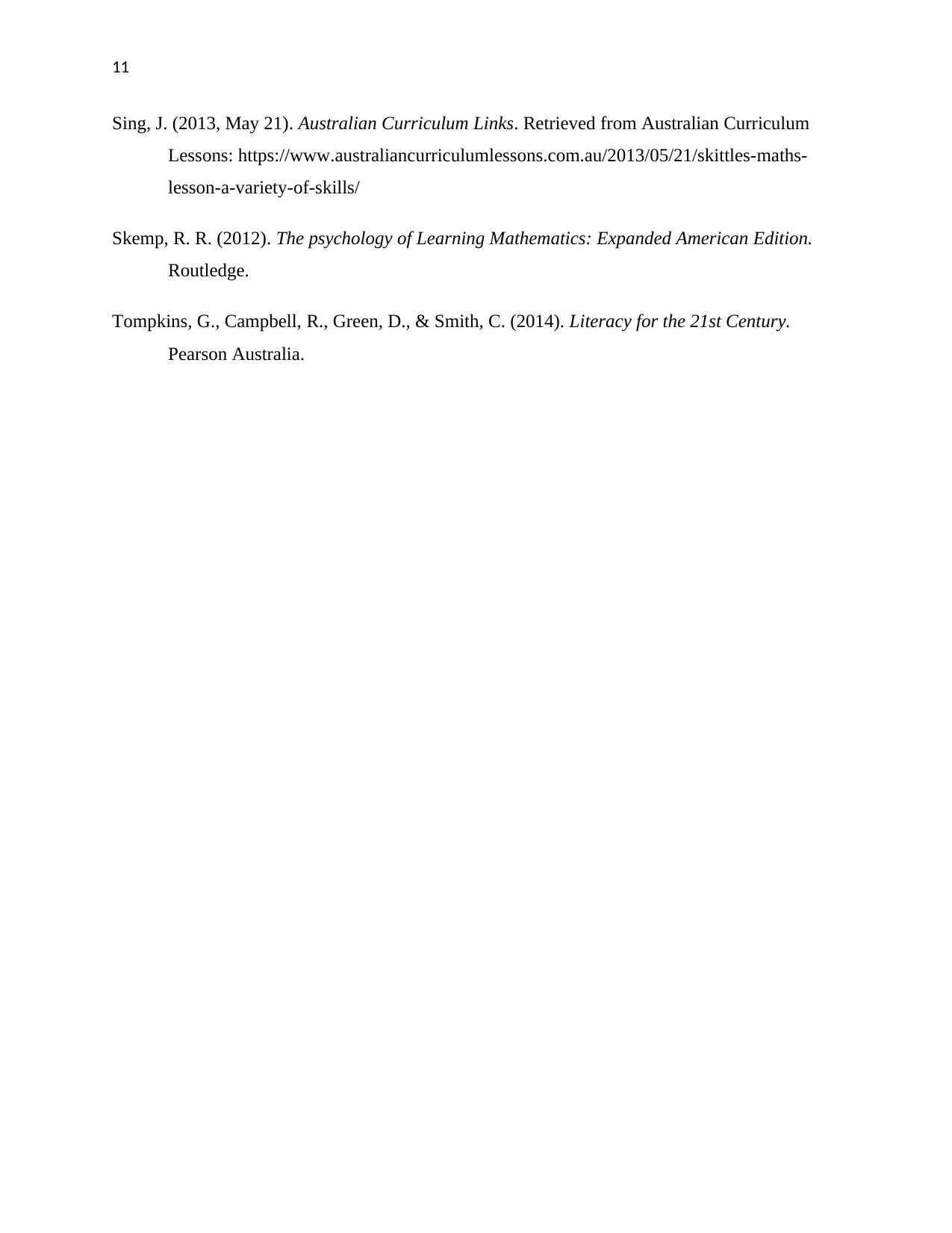
11
Sing, J. (2013, May 21). Australian Curriculum Links. Retrieved from Australian Curriculum
Lessons: https://www.australiancurriculumlessons.com.au/2013/05/21/skittles-maths-
lesson-a-variety-of-skills/
Skemp, R. R. (2012). The psychology of Learning Mathematics: Expanded American Edition.
Routledge.
Tompkins, G., Campbell, R., Green, D., & Smith, C. (2014). Literacy for the 21st Century.
Pearson Australia.
Sing, J. (2013, May 21). Australian Curriculum Links. Retrieved from Australian Curriculum
Lessons: https://www.australiancurriculumlessons.com.au/2013/05/21/skittles-maths-
lesson-a-variety-of-skills/
Skemp, R. R. (2012). The psychology of Learning Mathematics: Expanded American Edition.
Routledge.
Tompkins, G., Campbell, R., Green, D., & Smith, C. (2014). Literacy for the 21st Century.
Pearson Australia.
1 out of 11
Related Documents
Your All-in-One AI-Powered Toolkit for Academic Success.
+13062052269
info@desklib.com
Available 24*7 on WhatsApp / Email
![[object Object]](/_next/static/media/star-bottom.7253800d.svg)
Unlock your academic potential
Copyright © 2020–2025 A2Z Services. All Rights Reserved. Developed and managed by ZUCOL.





